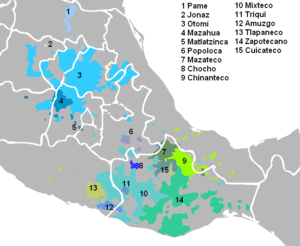Tlapanec language
| Tlapanec | |
|---|---|
| Me'phaa | |
| Native to | Mexico |
| Region | Guerrero, Morelos |
| Ethnicity | Tlapanec people |
Native speakers | 120,000 (2010 census)[1] |
|
Oto-Mangue
| |
| Language codes | |
| ISO 639-3 |
Variously: tcf – Malinaltepec (east) tpc – Azoyú (south) tpl – Tlacoapa (central) tpx – Acatepec (west) |
Linguist list |
qpc Tlapanec |
| Glottolog |
subt1249 (Tlapanec + Subtiaba)[2] |
|
Tlapaneco (Ochre, number 13) and the rest of the modern Oto-Manguean languages. | |
Tlapanec /ˈtlæpənɛk/ is an indigenous Mexican language spoken by more than 98,000 Tlapanec people in the state of Guerrero.[3] Like other Oto-Manguean languages, it is tonal and has complex inflectional morphology. The ethnic group themselves refer to their ethnic identity and language as Me'phaa [meʔpʰaː].[4]
Before much information was known about it, Tlapanec (sometimes written "Tlappanec" in earlier publications) was either considered unclassified or linked to the controversial Hokan language family. It is now definitively considered part of the Oto-Manguean language family, of which it forms its own branch along with the extinct and very closely related Subtiaba language of Nicaragua.[5]
Me'phaa people temporarily move to other locations, including Mexico City, Morelos and various locations in the United States, for reasons of work.
Varieties
Ethnologue distinguishes four Tlapanec languages:[6]
- Acatepec (dialects Acatepec proper, Huitzapula, Nanzintla, Teocuitlapa, Zapotitlán Tablas)
- Azoyú
- Malinaltepec (dialect Huehuetepec/Zilacayotitlán)
- Tlacoapa (dialects Tlacoapa proper, Tenamazapa)
Other sources of information, including native speakers and the Instituto Nacional de Lenguas Indígenas of the Mexican government, identify eight or nine varieties, which have been given official status: Acatepec, Azoyú, Malinaltepec, Tlacoapa, Nancintla, Teocuitlapa, Zapotitlán Tablas (with Huitzapula sometimes considered distinct), Zilacayotitlán.[7] These share mutual intelligibility of 50% between Malinaltepec and Tlacoapa, though Acatepec has an 80% intelligibility of both.
The Azoyú variety is the only natural language reported to have used the pegative case, though it is verbal case like other 'case' markers in Tlapanec.[8]
Grammar
Tlapanec is an ergative-absolutive language. However, while most languages of this type have an overt ergative case, Tlapanec is one of the rare examples of a marked absolutive language, that is, an ergative language that overtly marks the absolutive and leaves the ergative unmarked[9]
Media
Tlapanec-language programming is carried by the CDI's radio station XEZV-AM, broadcasting from Tlapa de Comonfort, Guerrero.
Notes
- ↑ INALI (2012) México: Lenguas indígenas nacionales
- ↑ Hammarström, Harald; Forkel, Robert; Haspelmath, Martin; Bank, Sebastian, eds. (2016). "Tlapanec + Subtiaba". Glottolog 2.7. Jena: Max Planck Institute for the Science of Human History.
- ↑ INEGI 2005: http://cuentame.inegi.org.mx/impresion/poblacion/lindigena.asp
- ↑ Instituto Nacional de Lenguas Indígenas. 2008. Catálogo de las lenguas indígenas nacionales: Variantes lingüísticas de México con sus autodenominaciones y referencias geoestadísticas. Diario Oficial 14 enero, Primera Sección: 31-78, Segunda Sección: 1-96, Tercera Sección: 1-112.
- ↑ See Suárez (1977; 1986).
- ↑ Computer-generated list of Tlapanec languages at Ethnologue (2013)
- ↑ A 2008 proposal to divide the ISO code for Acatepec into Acatepec proper, Teocuitlapa, Zapotitlan Tablas, and Huitsapula was rejected.
- ↑ Wichmann (2005).
- ↑ Donohue, Mark (2008).
References
- Donohue, Mark (2008). "Semantic alignment systems: what's what, and what's not". In Donohue, Mark & Søren Wichmann. The Typology of Semantic Alignment. Oxford: Oxford University Press. p. 27.
- Fernández de Miranda, María Teresa (1968). "Inventory of Classificatory Materials". In Norman A. McQuown (volume editor). Handbook of Middle American Indians, Vol. 5: Linguistics. R. Wauchope (general editor). Austin: University of Texas Press. pp. 63–78. ISBN 0-292-73665-7. OCLC 277126.
- Instituto Lingüístico de Verano (n.d.). "Tlapanecan family". El Instituto Lingüístico de Verano en México. Retrieved 2007-03-13.
- Marlett, Stephen A. (Ed.) (2011). "Los archivos lingüísticos me'phaa.". SIL International.
- Sapir, Edward (1925). "The Hokan affinity of Subtiaba in Nicaragua". American Anthropologist (New Series). 27 (3,4): 402–435, 491–527. doi:10.1525/aa.1925.27.3.02a00040.
- Suárez, Jorge A. (1977). El tlapaneco como lengua Otomangue (MS) (in Spanish). México, D.F.: Universidad Nacional Autónoma de México.
- Suárez, Jorge A. (1983). La lengua tlapaneca de Malinaltepec (in Spanish). México, D.F.: Universidad Nacional Autonoma de México, Instituto de Investigaciones Filologicas. ISBN 968-5805-07-5.
- Suárez, Jorge A. (1986). "Elementos gramaticales otomangues en tlapaneco". In Benjamin F. Elson (ed.). Language in global perspective (Papers in honor of the 50th anniversary of the Summer Institute of Linguistics 1935-1985. Dallas: The Summer Institute of Linguistics. ISBN 9780883126622.
- Swadesh, Morris (1968). "Lexicostatistic Classification". In Norman A. McQuown (volume editor). Handbook of Middle American Indians, Vol. 5: Linguistics. R. Wauchope (general editor). Austin: University of Texas Press. pp. 79–116. ISBN 0-292-73665-7. OCLC 277126.
- Weathers, Mark L. (1976). "Tlapanec 1975". International Journal of American Linguistics. 42 (4): 367–371. doi:10.1086/465442. JSTOR 1264270.
- Weathers, Mark L.; Abad Carrasco Zúñiga (1989). Xó nitháán mè’phàà: Cómo se escribe el tlapaneco. México, D.F.: Editorial Cuajimalpa.
- Wichmann, Søren (2005). "Tlapanec Cases" (PDF). In Rosemary Beam de Azcona and Mary Paster (eds.). Report 13, Survey of California and Other Indian Languages. Conference on Otomanguean and Oaxacan Languages, March 19–21, 2004. Berkeley CA: University of California at Berkeley. pp. 133–145. Retrieved 2007-03-12.
External links
- SIL description of Tlapanecan languages
- Listen to a sample of Acatepec Me'phaa from Global Recordings Network
